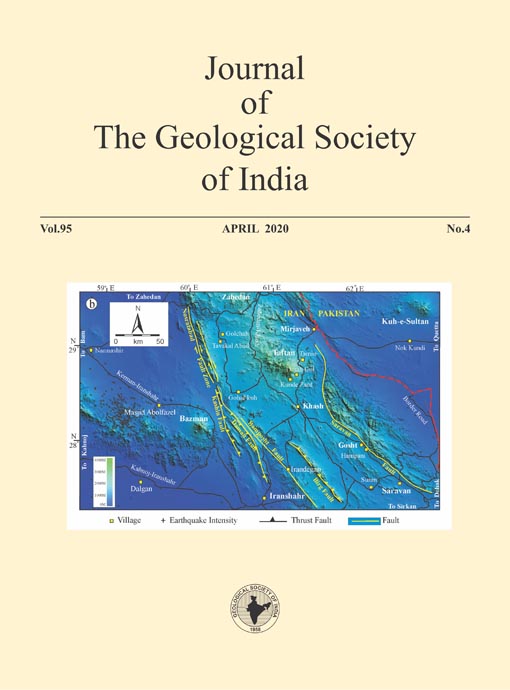Characterisation of Uranium Mining and Tailings Pond Areas by Integrated Remote Sensing, Geophysical, Geological and Hydrogeological Methods
DOI:
https://doi.org/10.1007/s12594-020-1446-8Keywords:
No Keywords.Abstract
Remote sensing, geophysical, geological and hydrogeological methods were used to characterise the aquifer of a proposed uranium mining and tailings pond area in India. Examination of lithologs show uranium occurrence at the Eparchaean unconformity at a depth of about 50 to 60 m below the surface. Resistivity studies showed four distinct zones-top soil, highly weathered, moderately weathered/fractured rock and massive rock. Wells tap groundwater from the weathered and fractured zones. Highly weathered nature of the intrusives, dykes and faults do not allow them to act as barriers to groundwater flow. Rainfall is the major source of groundwater recharge apart from irrigation return flow. Recharge to unconfined aquifers is primarily by downward seepage of rainfall through the unsaturated zone. Groundwater flows towards southeast. Pumping tests resulted in hydraulic conductivity of this aquifer ranging from 5.4 to 19.3 m/d. Infiltration rates were obtained at 1.5 and 2.3 m/d for clayey residual unconsolidated materials and 3.7 and 5.2 m/d for sandy residual unconsolidated materials. Secondary data were used to verify the results of field tests and investigations. Results from this study were also successfully used in radionuclide and geochemical modelling of the effects of leaching from the tailings pond on groundwater quality and its impact on human health. This detailed study provides a wider understanding of the sub-surface characteristics of the proposed uranium mining and tailings pond area which offers useful information for future research and development activities.Downloads
Metrics
Issue
Section
Downloads
Published
How to Cite
References
Brindha, K. and Elango, L. (2012) Occurrence of uranium in groundwater of a shallow granitic aquifer and its suitability for domestic use in southern India. Journal of Radioanalytical and Nuclear Chemistry, v.295, pp.357-367. DOI:10.1007/s10967-012-2090-6
Brindha, K. and Elango, L. (2013) Geochemistry of Fluoride Rich Groundwater in a Weathered Granitic Rock Region, Southern India. Water Quality, Exposure and Health, v.5, pp.127-138. DOI:10.1007/s12403-0130096-0
Brindha, K. and Elango, L. (2014a) Geochemical Modelling of the Effects of a Proposed Uranium Tailings Pond on Groundwater Quality. Mine Water and the Environment, v.33, pp.110-120. DOI:10.1007/s10230-0140279-3
Brindha, K. and Elango, L. (2014b) Spatial analysis of soil fertility in a part of Nalgonda district, Andhra Pradesh, India. Earth Science India, v.7, pp.36-48.
Brindha, K. and Elango, L. (2015) Cross comparison of five popular groundwater pollution vulnerability index approaches. Jour. Hydrology, v.524, pp.597-613. DOI:10.1016/j.jhydrol.2015.03.003
Brindha, K., Elango, L. and Nair, R.N. (2011) Spatial and temporal variation of uranium in a shallow weathered rock aquifer in southern India. Jour. Earth System Sci., v.120, pp.911-920.
Brindha, K., Jagadeshan, G., Kalpana, L. and Elango, L. (2016) Fluoride in weathered rock aquifers of southern India: Managed Aquifer Recharge for mitigation. Environ. Sci. Pollut. Res. Int., v.23, pp.8302-8316. DOI:10.1007/s11356-016-6069-7
CGWB (2013) Ground Water Brochure, Nalgonda district, Andhra Pradesh, Ministry of Water Resources, Government of India. Available from http://cgwb.gov.in/District_Profile/Telangana/Nalgonda.pdf accessed on 3rd December 2019. p.17
Chaki, A., Purohit, R.K., Mamallan, R. (2011) Low grade uranium deposits of India - a bane or boon. Energy Procedia, v.7, pp.153-157. DOI:10.1016/j.egypro.2011.06.020
DAE (Undated) Shaping the Third Stage of Indian Nuclear Power Programme, Department of Atomic Energy, Government of India.
Elango L, Brindha K, Kalpana L, Sunny F, Nair RN, Murugan R (2012) Groundwater flow and radionuclide decay-chain transport modelling around a proposed uranium tailings pond in India. Hydrogeology Journal 20:797-812. DOI:10.1007/s10040-012-0834-6
GSI (1995) Geology and minerals map of Nalgonda district Andhra Pradesh. Geological Survey of India, Government of India.
Gupta, R. and Sarangi, A.K. (2005) Emerging Trend of Uranium Mining: The Indian Scenario, IAEA International symposium on "Uranium production and raw materials for the nuclear fuel cycle- Supply and demand, economics, the environment and energy security", Vienna. pp 47-56.
Orellana, E. and Mooney, H.M. (1966) Master Tables and Curves for Vertical Electrical Sounding Over Layered Structures. Interciencia, Madrid, pp.34.
Parihar, P.S. (2013) Uranium and thorium resources in India: UNFC system, UNFC workshop, India. Available from: https://www.unece.org/fileadmin/DAM/energy/se/pp/unfc/UNFC_ws_India_Oct2013/5b.2_Parihar.pdf Accessed on 3rd December 2019.
Rajaveni, S.P., Brindha, K. and Elango, L. (2015) Geological and geomorphological controls on groundwater occurrence in a hard rock region. Applied Water Science, v.7, pp.1377-1389. DOI:10.1007/s13201015-0327-6
Rajaveni, S.P., Brindha, K., Rajesh, R. and Elango, L. (2014) Spatial and Temporal Variation of Groundwater Level and its Relation to Drainage and Intrusive Rocks in a part of Nalgonda District, Andhra Pradesh, India. Jour. Indian Soc. Remote Sensing, v.42, pp.765-776. DOI:10.1007/ s12524-013-0328-6
Rajesh, R., Brindha, K., Murugan, R. and Elango, L. (2012) Influence of hydrogeochemical processes on temporal changes in groundwater quality in a part of Nalgonda district, Andhra Pradesh, India. Environ. Earth Sci., v.65, pp.1203-1213. DOI:10.1007/s12665-011-1368-2
Reddy, D.V., Nagabhushanam, P., Sukhija, B.S., Reddy, A.G.S. and Smedley, P.L. (2010) Fluoride dynamics in the granitic aquifer of the Wailapally watershed, Nalgonda District, India. Chemical Geol., v.269, pp.278-289. DOI: 10.1016/j.chemgeo.2009.10.003
Reddy, K.V.K., Reddy, B.S., Reddy, M.S., Reddy, C.G., Reddy, P.Y. and Reddy, K.R. (2003) Baseline studies of radon/thoron concentration levels in and around the Lambapur and Peddagattu areas in Nalgonda district, Andhra Pradesh, India. Radiation Measurements, v.36, pp.419-423. DOI:101016/S1350-4487(03)00163-X
Singh, R.V., Sinha, R.M., Bisht, B.S., Banerjee, D.C. (2002) Hydrogeochemical exploration for unconformity-related uranium mineralization: example from Palnadu sub-basin, Cuddapah Basin, Andhra Pradesh, India. Jour. Geochem. Explor., v.76, pp.71-92. DOI: 10.1016/S0375-6742(02)002182
Sinha, R.M., Saxena, V.P. (2003) Cuddapah basin: A store-house for uranium deposits. Nuclear India, v.37.
Sinha, R.M., Shrivastava, V.K., Sarma, G.V.G., Parthasarathy, T.N. (1995) Geological favourability for unconformity-related Uranium deposits in northern parts of the Cuddapah Basin: evidences from Lambapur Uranium occurrences, Andhra Pradesh, India. Exploration and Research for Atomic Minerals, v.8, pp.111-126.

 K. Brindha
K. Brindha






